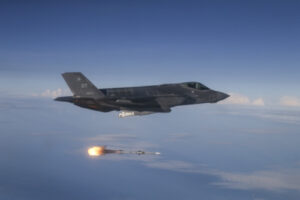Helicopter News
-
 Uncategorized
UncategorizedNavy Finishes Key Tests Of Fire Scout, MQ-25 UAVs
The Navy announced the week of April 10 that it has completed key tests of two unmanned aerial vehicles: the new MQ-8C Fire Scout helicopter and the future MQ-25 Stingray […]
-
 Uncategorized
UncategorizedAir Force Blames MQ-9A Reaper Crash On Pilot Error
Investigators concluded that pilot error caused an Air Force MQ-9A Reaper unmanned aircraft to crash at Kandahar Airfield in Afghanistan in 2016, the service announced April 13. According to Air […]
-
 Uncategorized
UncategorizedSingapore Starts Upgrading AH-64D Apache Fleet
The Republic of Singapore Air Force (RSAF) is beginning to upgrade its AH-64D Apache fleet with new electronic warfare and communications systems, the Singapore Ministry of Defence said April 20. […]
-
 Uncategorized
UncategorizedAirbus And IAR Sign Agreement For Cooperation On Romanian H215M
Airbus and majority Romania’s IAR Brasov signed an agreement for exclusive cooperation on Romanian H215M multi-role helicopters, Airbus said April 13. Under the general agreement, IAR will become the prime […]
-
 Uncategorized
UncategorizedAir Force Releases Second Draft RFP For UH-1N Replacement
The Air Force, as promised, released its second draft request for proposal (RFP) for its UH-1N replacement program on April 20. Air Force spokeswoman Capt. Emily Grabowski said in statement […]
-
HN for Wed., April 12, 2017
- Presidential Helicopter Replacement Will Take Maiden Flight This Summer
- Pentagon OKs Initial Production of Marine Corps CH-53K Heavy Lift Helicopter
- DARPA, Aurora Finish Flight Tests Of Subscale VTOL X-Plane
- Marine Corps Awaiting Pentagon Green Light To Launch CH-53K Production
- $3.4B Multi-Year Apache Contract Expedites Future Foreign Military Sales, Saves Army 10 Percent
- Army Awards Boeing $3.3 Billion Contract For Saudi Arabia Apaches
- Navy Will Delay H-60 Service Life Extension Without Defense Budget
- U.S. Navy Awards Elbit Systems $50 Million Contract For MH-60S Helmet Display And Processor
-
 Uncategorized
UncategorizedU.S. Navy Awards Elbit Systems $50 Million Contract For MH-60S Helmet Display And Processor
The U.S. Navy awarded Elbit Systems [ESLT] a $50 million indefinite delivery, indefinite quantity (IDIQ) contract to provide helmet displays with a mission processor algorithm for the MH-60s, the company […]
-
 Uncategorized
UncategorizedNavy Will Delay H-60 Service Life Extension Without Defense Budget
NATIONAL HARBOR, Md. – Without a fiscal year 2017 budget in place, the Navy will delay a service life extension plan necessary to fly its Sikorsky MH-60R/S Seahawk helicopters into […]
-
 Uncategorized
UncategorizedArmy Awards Boeing $3.3 Billion Contract For Saudi Arabia Apaches
The Army on Wednesday awarded Boeing [BA] a $3.3 billion contract modification to provide Apache helicopters to Saudi Arabia, according to a Pentagon statement. The contract modification is a multi-year […]
